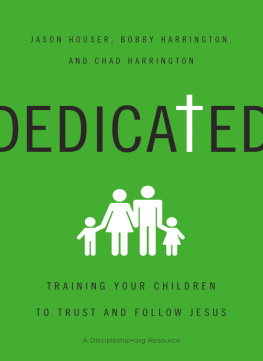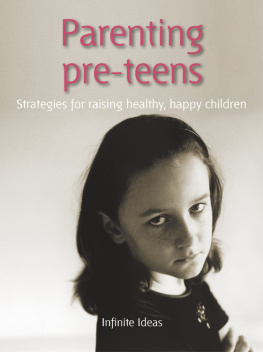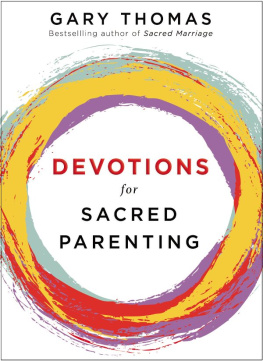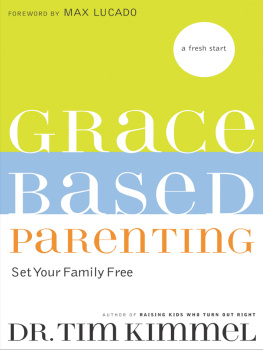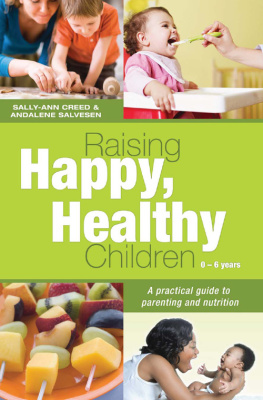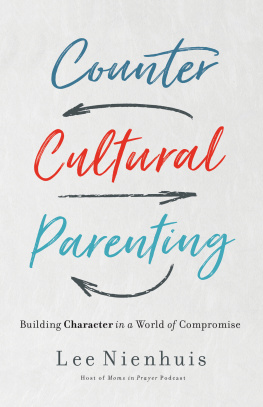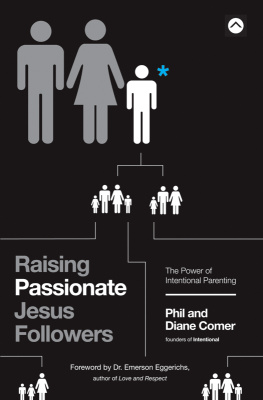Notes
Chapter 3Kissing the World Good-Bye
. C. S. Lewis, The Screwtape Letters , (New York, NY: Harper Collins, 1942), 44.
Chapter 4Free Indeed
.
.Carter, Enabling Behavior.
.Jim Burns, Creating an Intimate Marriage: Rekindle Romance Through Affection, Warmth and Encouragement (Grand Rapids, MI: Bethany, 2007), 159.
.Gary Thomas, The Sacred Search: What If Its Not about Who You Marry, But Why? (Colorado Springs, CO: David C Cook, 2013), 18.
Chapter 5Beyond the Pursuit of Perfection
.Randy Frazee, The Heart of the Story (Grand Rapids, MI: Zondervan, 2011), 1819.
.
Chapter 7A Time to Bless
, emphasis added.
.Carattini, On Blessing.
.Gary Smalley and John Trent, The Blessing: Giving the Gift of Unconditional Love and Acceptance (Nashville, TN: Thomas Nelson).
Chapter 8Living a Meaningful Family Mission
.
Chapter 9Beyond Good Behavior and Chore Charts
.
. Used with permission.
.Ruth Haley Barton, Strengthening the Soul of Your Leadership: Seeking God in the Crucible of Ministry (Downers Grove, IL: InterVarsity Press, 2008), 16.
.M. Robert Mulholland Jr., Invitation to a Journey: A Road Map for Spiritual Formation (Downers Grove, IL: InterVarsity Press, 1993), 12.
Chapter 10Remember and Celebrate the Abundant Life
.Michael J. Anthony, Exploring the History and Philosophy of Christian Education: Principles for the 21st Century (Grand Rapids, MI: Kregel, 2003), 35.
.Michael J. Anthony and Michelle Anthony, A Theology for Family Ministries (Nashville, TN: B&H, 2011), 226.
.
.Michelle Anthony, Dreaming of More for the Next Generation: Lifetime Faith Ignited by Family Ministry (Colorado Springs, CO: David C Cook, 2012), 14546.
.Leon Blanchette in Michael J. and Michelle Anthony , A Theology of Family Ministry (Nashville, TN: Broadman and Holman, 2011), 119.
.Blanchette, Theology of Family Ministry , 125.
.Adapted from Blanchette, Theology of Family Ministry , 125, 129, 131, 132, 133.
.Michelle Anthony, Spiritual Parenting: An Awakening for Todays Families (Colorado Springs, CO: David C Cook, 2010), 96.
.
APPENDIX A
The Ten Environments
1. Storytelling
The Big God Story gives us an accurate and awe-inspiring perspective into how God has been moving throughout history. It is the story of redemption, salvation, and hope, and tells how we have been grafted into it by grace. It further compels us to see how God is using every persons life and is creating a unique story that deserves to be told for His glory.
God has a big story, and I can be a part of it!
2. Identity
This environment highlights who we are in Christ. According to Ephesians 1, we have been chosen, adopted, redeemed, sealed, and given inheritances in Christall of which we did nothing to earn. This conviction allows children to stand firm against the destructive counter identities the world offers.
I belong to God, and He loves me!
3. Faith Community
God designed us to live in community and to experience Him in ways that can happen only in proximity to one another. The faith community creates an environment to equip and disciple parents, to celebrate Gods faithfulness, and to bring a richness of worship through tradition and rituals that offer children an identity. Our love for each other reflects the love we have received from God.
Gods family cares for one another and worships God together.
4. Service
This posture of the heart asks the question, What needs to be done? It allows the Holy Spirit to cultivate in us a sensitivity to others and helps us focus on a cause bigger than our individual lives. Serving others helps us fulfill the mandate as Christ-followers to view our lives as living sacrifices that we generously give away.
What needs to be done?
5. Out of the Comfort Zone
As children and students are challenged to step out of their comfort zones from an early age, they experience a dependence on the Holy Spirit to equip and strengthen them beyond their natural abilities and desires. We believe this environment will cultivate a generation of individuals who, instead of seeking comfort, seek radical lives of faith in Christ.
God transforms me when I step out in faith.
6. Responsibility
This environment captures the ability to take ownership of our lives, gifts, and resources before God. A child must be challenged to take responsibility for his or her brothers and sisters in Christ, as well as for those who are spiritually lost. We hope the Holy Spirit will use this environment to allow us to understand that God has entrusted His world to each of His children.
God has entrusted me with the things and people He created around me.
7. Course Correction
This environment flows out of Hebrews 12:1113 and is the direct opposite of punishment. Instead, biblical discipline for a child encompasses a season of pain, then building up in love, followed by a vision of a corrected pathall with the purpose of healing at its core.
When I get off track, God offers me a path of healing.
8. Love and Respect
Without love, our faith is futile. Children need an environment of love and respect in order to be free to both receive and give Gods grace. This environment declares that children are respected because they embody the image of God. We must speak to our children, not at them, and we must commit to an environment where love and acceptance are never withheld due to a childs behavior.
God fills me with His love so I can give it away.
9. Knowing
Nothing could be more important than knowing and being known by God. We live in a world that denies absolute truth, yet Gods Word offers just that. As we create an environment that upholds and displays Gods truth, we give children a foundation based on knowing God, His Word, and a relationship with Him through Christ. God is holy, mighty, and awesome, yet He has chosen to make Himself known to us!
God knows me, and I can know Him.
10. Modeling
Biblical content requires a practical, living expression in order for it to be spiritually influential. This environment gives hands-on examples of what it means for children to put their faith into action. Modeling puts flesh on faith and reminds us that others are watching to see if we live what we believe.
I see Christ in others, and they can see Him in me.
APPENDIX B
Questions to Consider in Writing a Family Mission Statement
What kind of family life do you want your children to remember?
What kind of atmosphere do you want to have in your home?
What kind of family do you want to be known for?
What kind of parent do you want to be?
What behaviors do you want your family members to demonstrate?
What goals will you have for your children at various stages of their lives?
What are some of your fondest childhood memories?
What painful experiences did you have in your family that you do not feel would benefit your children if replicated?
What kinds of biblical qualities do you believe children should exhibit?
What mode of discipline do you feel is best in your home?
What changes do you need to make in order to allow your family to have more time/fun together?
What perspectives should your children encounter other than the ones that they are naturally exposed to? (Think of culture, economics, politics, and so on.)
What are you willing to sacrifice in order to accomplish these plans?
APPENDIX C
Writing a Mission Statement
But those who plan what is good find love and faithfulness.
Proverbs 14:22
1. As you begin to think through your mission statement, write down three things that you want for your family and children as an end result . What do you hope to see when they are young adults someday? (For example, to live lives in accordance with Gods laws and grace, to reflect the character of God, to demonstrate a life of love, and so on.) These are essentially value statements.
Next page

